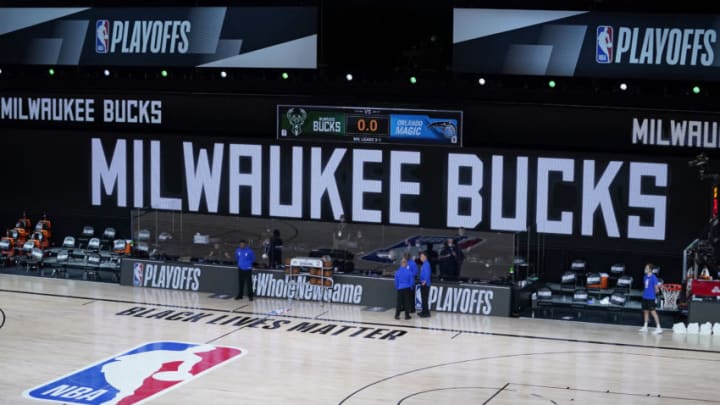The Milwaukee Bucks’ historic walkout decision last week has been lauded by most, but has also exposed a difference of opinions on what is right.
The Milwaukee Bucks‘ players made a momentous statement last week as they staged a walkout ahead of their originally scheduled Game 5.
That spontaneous choice had a ripple effect within the NBA and other major sports leagues in this country. The purpose of the Bucks and other teams’ protests was to continue to spark change in America’s current climate of social injustice and systemic oppression.
More from Bucks News
- Bucks 2023-24 player profile: Can MarJon Beauchamp take a leap?
- Piecing together the Milwaukee Bucks’ dream starting 5 in 5 years
- Predicting Thanasis Antetokounmpo’s 2023-24 stats for the Bucks
- Grade the trade: Bucks land reputable backup guard in swap with Pacers
- New workout video should have Milwaukee Bucks fans excited
After the players decided to resume the season, the Bucks won Game 5 to move to the second round of the playoffs. The importance of their win is that they can continue to spread their message.
Listening to commentators and reading news articles, many Americans supported the players’ call to action. The Bucks’ refusal to play and subsequent suspension of games has already led to significant conversations and change. But that is the thing: Many Americans, not all.
While most have applauded the teams’ nonviolent actions, there are still others who expect the athletes to “shut-up and dribble.” All it takes is a glance through the comments section or social media of your favorite basketball, football, hockey, or baseball team not playing a game or practicing, to see the vitriol thrown at these teams and players.
Most of us know someone in our life who does not understand why these teams are making these choices. Most of us know someone in our life who simply refuses to listen and learn about what other people, including our athletes, have to say about why they are making this stand.
The shooting of Jacob Blake and what is happening in the Bucks’ home state of Wisconsin, is a prime example of the angry chasm that showcases both sides of this argument, which illuminates the realities and as all things are now, the politics of a given situation. Not the argument of right and wrong, per se, but the relativism of it all: “What I think is right, is what you think is wrong and vice versa.”
The problem with this conflict, as with many others, is there is more than just one core issue. One can unpack the layers in a long list: police brutality, systemic racism, 2nd Amendment rights, peaceful protests vs. riots, etc.
The Bucks and many others, including this writer, see what happened to this man, this Black man, and are appalled by a police officer playing the role of judge, jury, and executioner. Others insist that Mr. Blake was a criminal with a warrant that walked away from police.
The Bucks and others support the peaceful protests of Mr. Blake’s shooting; the fight for social justice and police reform. But, what happens when the protests are as violent as they have been in Kenosha? The line crossed to rioting. Downtown Kenosha has been besieged by violence the past week.
The Bucks and many other Americans are shocked that a 17-year-old kid can walk around with a machine gun and kill two people. But, many American citizens think this kid is some sort of hero.
The divide in ideology is so great that it provokes thought of one simpler issue: humanity. Right and wrong.
Who is on the right side of history? The Milwaukee Bucks or the other people?
There is only one stance on what is right.
Still one of the novels taught in high schools across America, one that has been taught for many decades, is the novel To Kill a Mockingbird. Harper Lee’s 1960 American classic reflects on the Deep South in the 1930s. It’s about family, human nature, the importance of empathy, and race relations. All themes still relevant in this current crisis.
Lee uses this novel as a message to her audience of the early 1960s, about the importance of civil rights for Black Americans. Equality. It was no coincidence this book was written and released during the Civil Rights Movement. There is a scene in the book where a character, a Black man by the name of Tom Robinson, who has wrongly been convicted of a crime by a White jury, is trying to escape prison and is shot 17 times in the back. 17 times by the guards. 17 times.
Jacob Blake was shot in the back seven times for walking away from the police. Seven times by one officer. Seven times.
I know what one side of the conversation in recent days will be thinking now; the fictional Tom Robinson was innocent. But, Jacob Blake is still a human being.
Eighty years after this fictional scene in the novel, I cannot stop thinking about this horrific symmetry, and the tragic cycle makes it completely clear why our Milwaukee Bucks did not come out of that locker room, and why they will continue to fight for what is right and be the moral compass the state and nation needs. As a Bucks’ fan, I could not be prouder of this franchise.
Our Milwaukee Bucks will be on the right side of history.
